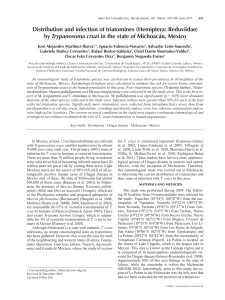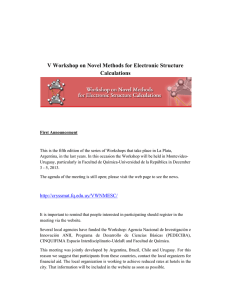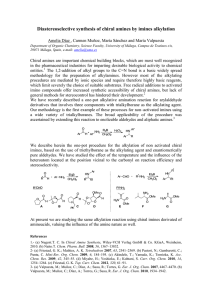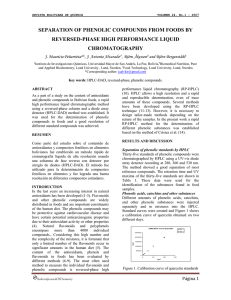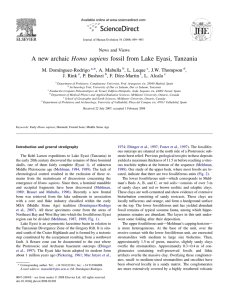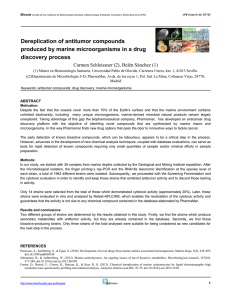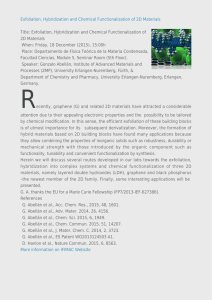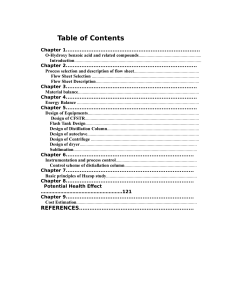Insight into the Bioreductive Mode of Action of
Anuncio
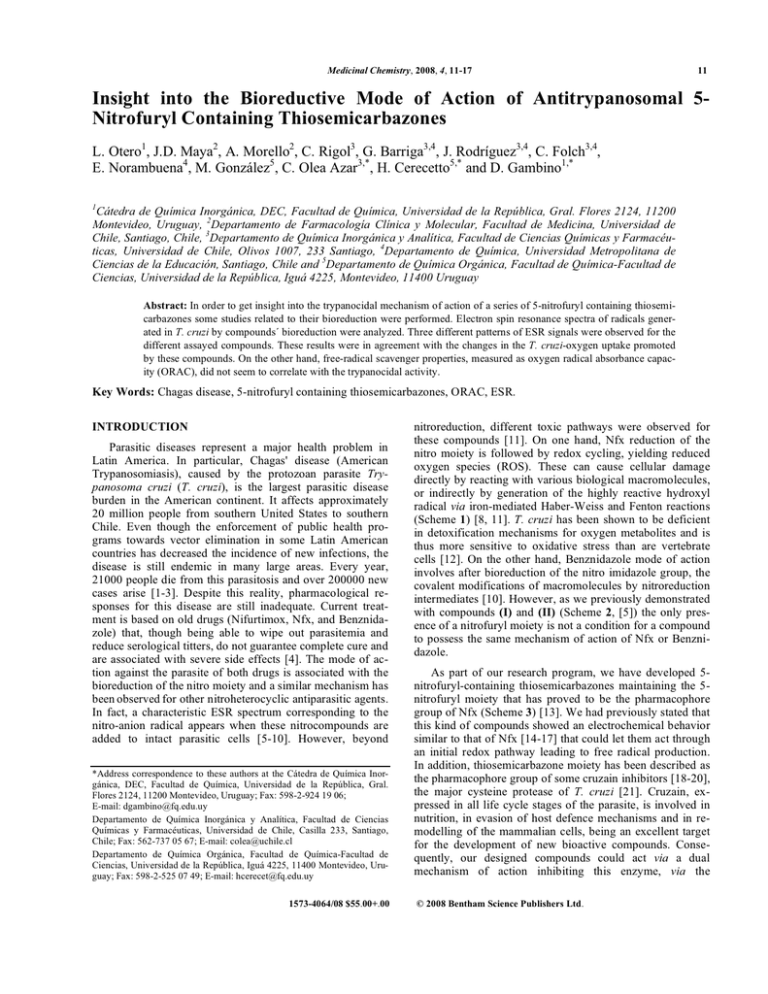
Medicinal Chemistry, 2008, 4, 11-17 11 Insight into the Bioreductive Mode of Action of Antitrypanosomal 5Nitrofuryl Containing Thiosemicarbazones L. Otero1, J.D. Maya2, A. Morello2, C. Rigol3, G. Barriga3,4, J. Rodríguez3,4, C. Folch3,4, E. Norambuena4, M. González5, C. Olea Azar3,*, H. Cerecetto5,* and D. Gambino1,* 1 Cátedra de Química Inorgánica, DEC, Facultad de Química, Universidad de la República, Gral. Flores 2124, 11200 Montevideo, Uruguay, 2Departamento de Farmacología Clínica y Molecular, Facultad de Medicina, Universidad de Chile, Santiago, Chile, 3Departamento de Química Inorgánica y Analítica, Facultad de Ciencias Químicas y Farmacéuticas, Universidad de Chile, Olivos 1007, 233 Santiago, 4Departamento de Química, Universidad Metropolitana de Ciencias de la Educación, Santiago, Chile and 5Departamento de Química Orgánica, Facultad de Química-Facultad de Ciencias, Universidad de la República, Iguá 4225, Montevideo, 11400 Uruguay Abstract: In order to get insight into the trypanocidal mechanism of action of a series of 5-nitrofuryl containing thiosemicarbazones some studies related to their bioreduction were performed. Electron spin resonance spectra of radicals generated in T. cruzi by compounds´ bioreduction were analyzed. Three different patterns of ESR signals were observed for the different assayed compounds. These results were in agreement with the changes in the T. cruzi-oxygen uptake promoted by these compounds. On the other hand, free-radical scavenger properties, measured as oxygen radical absorbance capacity (ORAC), did not seem to correlate with the trypanocidal activity. Key Words: Chagas disease, 5-nitrofuryl containing thiosemicarbazones, ORAC, ESR. INTRODUCTION Parasitic diseases represent a major health problem in Latin America. In particular, Chagas' disease (American Trypanosomiasis), caused by the protozoan parasite Trypanosoma cruzi (T. cruzi), is the largest parasitic disease burden in the American continent. It affects approximately 20 million people from southern United States to southern Chile. Even though the enforcement of public health programs towards vector elimination in some Latin American countries has decreased the incidence of new infections, the disease is still endemic in many large areas. Every year, 21000 people die from this parasitosis and over 200000 new cases arise [1-3]. Despite this reality, pharmacological responses for this disease are still inadequate. Current treatment is based on old drugs (Nifurtimox, Nfx, and Benznidazole) that, though being able to wipe out parasitemia and reduce serological titters, do not guarantee complete cure and are associated with severe side effects [4]. The mode of action against the parasite of both drugs is associated with the bioreduction of the nitro moiety and a similar mechanism has been observed for other nitroheterocyclic antiparasitic agents. In fact, a characteristic ESR spectrum corresponding to the nitro-anion radical appears when these nitrocompounds are added to intact parasitic cells [5-10]. However, beyond *Address correspondence to these authors at the Cátedra de Química Inorgánica, DEC, Facultad de Química, Universidad de la República, Gral. Flores 2124, 11200 Montevideo, Uruguay; Fax: 598-2-924 19 06; E-mail: [email protected] Departamento de Química Inorgánica y Analítica, Facultad de Ciencias Químicas y Farmacéuticas, Universidad de Chile, Casilla 233, Santiago, Chile; Fax: 562-737 05 67; E-mail: [email protected] Departamento de Química Orgánica, Facultad de Química-Facultad de Ciencias, Universidad de la República, Iguá 4225, 11400 Montevideo, Uruguay; Fax: 598-2-525 07 49; E-mail: [email protected] 1573-4064/08 $55.00+.00 nitroreduction, different toxic pathways were observed for these compounds [11]. On one hand, Nfx reduction of the nitro moiety is followed by redox cycling, yielding reduced oxygen species (ROS). These can cause cellular damage directly by reacting with various biological macromolecules, or indirectly by generation of the highly reactive hydroxyl radical via iron-mediated Haber-Weiss and Fenton reactions (Scheme 1) [8, 11]. T. cruzi has been shown to be deficient in detoxification mechanisms for oxygen metabolites and is thus more sensitive to oxidative stress than are vertebrate cells [12]. On the other hand, Benznidazole mode of action involves after bioreduction of the nitro imidazole group, the covalent modifications of macromolecules by nitroreduction intermediates [10]. However, as we previously demonstrated with compounds (I) and (II) (Scheme 2, [5]) the only presence of a nitrofuryl moiety is not a condition for a compound to possess the same mechanism of action of Nfx or Benznidazole. As part of our research program, we have developed 5nitrofuryl-containing thiosemicarbazones maintaining the 5nitrofuryl moiety that has proved to be the pharmacophore group of Nfx (Scheme 3) [13]. We had previously stated that this kind of compounds showed an electrochemical behavior similar to that of Nfx [14-17] that could let them act through an initial redox pathway leading to free radical production. In addition, thiosemicarbazone moiety has been described as the pharmacophore group of some cruzain inhibitors [18-20], the major cysteine protease of T. cruzi [21]. Cruzain, expressed in all life cycle stages of the parasite, is involved in nutrition, in evasion of host defence mechanisms and in remodelling of the mammalian cells, being an excellent target for the development of new bioactive compounds. Consequently, our designed compounds could act via a dual mechanism of action inhibiting this enzyme, via the © 2008 Bentham Science Publishers Ltd. 12 Medicinal Chemistry, 2008, Vol. 4, No. 1 Otero et al. Fe2+ SOD OH. + OH- H2O2 N O2N O O2 O2 N Me O2N N N O SO2 SO2 Me 1e- Nifurtimox Flavoprotein reductase nitro anion radical Scheme 1. Bioreductive pathway of Nfx. thiosemicarbazone moiety, and producing oxidative stress via the 5-nitrofuryl moiety. In these sense, even though a bioreductive pathway could also be responsible for toxicity on mammalian cells, the development of single agents that (1-3) or furylacroleine derivatives (4-6). Most of them resulted more active in vitro against T. cruzi than the parent drug Nfx being furylacroleine derivatives (4-6) the most potent ones (Table 1). Their ability to produce free radicals has O H N O2N O N (CH2)6CH3 O2N O N H O (CH2)6CH3 O (I) (II) ESR signal when it was incubated in the presence of T. cruzi microsomes No ROS production according to ESR studies Scheme 2. Previous studied 5-nitrofuryl derivatives with different mechanism of action. Compound (II), unlike Nfx and derivative (I), may act by inhibition of the parasite’s respiratory cycle without oxygen redox cycling [5]. provide maximal antiprotozoan activity by acting against multiple parasitic targets could diminish host toxic effects by lowering therapeutic dose. As shown in Scheme 3, the developed compounds can be included in one of the following series: furfural derivatives O2N also been demonstrated when they were incubated in presence of mammalian-liver microsomes [13]. In the present study, ESR and spin trapping experiments were performed in order to know if Nfx main mode of action remains in these compounds. Oxygen uptake experiments N O N SO2 Me Nifurtimox S H2N O2N O CHO S N H NHR O2N N O N H NHR p-TsOH / toluene Furfural derivatives -R= -H 1 -R= -Et 2 -R= -Ph 3 S H2N O2N O CH=CHCHO S N H NHR O2N p-TsOH / toluene Scheme 3. Selected 5-nitrofuryl-containing thiosemicarbazones. N O Furylacroleine derivatives N H NHR -R= -H 4 -R= -Et 5 -R= -Ph 6 Insight into the Bioreductive Mode of Action Table 1. Medicinal Chemistry, 2008, Vol. 4 No. 1 13 Experimental Hyperfine Splittings (Gauss), Effect of Thiosemicarbazone Derivatives Upon Culture Growth and Oxygen Uptake in T. cruzi Epimastigotes DMPO-OH Spin Adduct DMPO-nitro Spin Adduct Ref. PGI (%)a,[13] Resp. (%)b,c,d Oxygen Redox Cycling (%) d,e PGI (%)f,[13] aN (G) aH (G) aN (G) aH (G) 1 15.05 15.05 15.45 23.05 42 126 200 69 2 14.80 14.80 15.20 23.50 38 117 146 51 3 14.60 14.60 - - 15 103 111 14 4 14.60 14.60 15.45 23.05 65 117 180 74 5 14.70 14.70 15.20 23.70 80 106 127 74 6 - - - - 85 111 120 78 Nfx - - - - 50 127 190 46 h 100 - g C - - - - - 100 PGI: Percentage of growth inhibition of epimastigote T. cruzi (CL Brener strain) at 5 M at 5th day of treatment. b Respiration determined as nanoatoms-gram of oxygen/min/mg protein, concentration of compounds 150 M. c Increase in the rate of oxygen consumption. d For details, see Experimental Section. e Increase in the rate of oxygen consumption in presence of NaCN (20 M), concentration of compounds 600 M. f PGI: Percentage of growth inhibition of epimastigote T. cruzi (Tulahuen strain) at 5 M. g C: control. h Control respiration was 31.5 nanoatoms of oxygen per min and per mg of protein. a were also performed to evaluate the compounds as redox cycling agents. In addition, in order to study the free-radical scavenger properties of this family of compounds, oxygen radical absorbance capacity (using fluorescein (FL) as probe, ORACFL) studies were done. piration with cyanide [28-31]. All the assayed compounds (1-6) increased oxygen consumption, between 3-26 % rea RESULTS AND DISCUSSION Chemistry Derivatives 1-6 were obtained in good yield as Scheme 3 shows [13]. b ESR Evidence for Production of Free Radical Species by T. cruzi Incubation of compounds 1-6 with the epimastigote form of T. cruzi allowed us to detect free radicals generated by bioreduction promoted by the parasite. Experiments were performed in presence of DMPO in order to trap free radical species having short half-lives [5]. Three different patterns of ESR signals were observed for the different assayed compounds (Fig. (1)). Well-resolved ESR spectra appeared when compounds 1-5 were added to T. cruzi system. The ESR signal displacement was consistent with the trapping of both the hydroxyl radical and the nitroheterocycle radical for compounds 1, 2, 4, and 5 (Table 1). The hyperfine constants are in agreement with the splitting constants of other DMPO-OH adducts and nitrogen-centered radical trapping by DMPO [22, 23]. On the other hand, compound 3 produced an spectrum having the typical four lines of the DMPO-OH adduct (see Table 1). Finally, compound 6 did not produce ESR signal. OXYGEN UPTAKE EXPERIMENTS The involvement of the obtained compounds in redox cycling processes would increase the parasite oxygen consumption [24-27]. In this sense, oxygen uptake experiments were performed, with and without inhibition of T. cruzi res- c d e Fig. (1). ESR spectra observed after 5 minutes incubation at 28 ºC of compounds 2 (a), 3 (b) and 6 (c) (1 mM DMF solutions) with T. cruzi epimastigote (Brener CL strain, intact parasite, 7 mg protein/mL), NADPH (1 mM), EDTA (1mM), DMPO (100 mM) in phosphate buffer pH = 7.4. (d) Simulated ESR spectrum of DMPONitroradical adduct (e) Simulated ESR spectrum of DMPO-OH adduct. Spectrometer conditions: microwave frequency 9.68 GHz, microwave power 20mW, modulation amplitude 0.4 G, scan rate 0.83 G/s, time constant 0.25 s, number of scans 15. 14 Medicinal Chemistry, 2008, Vol. 4, No. 1 spect to untreated control (column 7, Table 1), and such effect is most clearly observed after inhibition of the parasite mitochondrial respiration (Table 1, Fig. (2a)). In the absence of drugs, cyanide-insensitive respiration is minor suggesting that cytochrome aa3 is the main T. cruzi terminal oxidase as previously observed [26]. Treatment with Nfx increased the cyanide-insensitive respiration to 90%, suggestive of superoxide/H2O2 production. This is in agreement with previous ESR results consistent with the trapping of hydroxyl radical (DMPO-OH adduct) when incubating a Nfx analogue with T. cruzi homogenates and the spin trap [6]. Treatment with the studied compounds 1-6 also produced increase in the cyanide-insensitive respiration respect to control to such high levels (100 and 80 % for derivative 1 and 4, respectively). In general, these results are in agreement with the ESR experiments, since they clearly show that compounds with DMPOOH presence, such as 1, 2, 4 and 5, produced redox cycling similarly to Nfx [5]. Compounds with no changes in the rate of oxygen consumption (percentage of respiration similar to control, Table 1), such as 3, or with the lowest oxygen redox cycling, such as 3 and 6, showed low concentration or absence of DMPO-OH adduct in the ESR experimental conditions. Since the compounds employed in this study are lipophilic we assumed that they are rapidly and almost completely absorbed by the parasites. However, the different bioavailability behavior in the ESR and oxygen uptake experimental conditions [13] could be the responsible of the lack of a good correlation between these results, as in the Otero et al. case of compound 6. Other facts involving free radical decomposition kinetic could explain the signals’ absence in the ESR. These experimental evidences support the idea that the main trypanocidal effect is not common for all the members of this family of thiosemicarbazones. The mechanistic difference between furfural thiosemicarbazones, derivatives 13, and furylacroleine thiosemicarbazones, derivatives 4-6, could be evidenced analyzing Fig. (2b). Meanwhile furfural thiosemicarbazones’ activities (marked as , Fig. (2b)) could be fit very well with oxygen uptake results (respiration and redox cycling), furylacroleine thiosemicarbazones’ activities (marked as , Fig. (2b)) present a random behavior. These results show that the members of this subgroup, 4-6, could act differentially between them. On the other hand, other physicochemical properties could certainly play a role in the displayed biological behavior, i.e. volume or lipophilic characteristics, given that derivatives 1 and 4, lacking thiosemicarbazone N4-substituent, resulted the best oxygen redox cycling agents while derivatives 3 and 6, bearing N4-phenyl substituent, resulted the worst. ORAC ASSAY The antioxidant activities of compounds 1-6 were further evaluated using the ORAC assay with ROO· species. The regression and correlation coefficients are given in Table 2. The results indicated that the scavenger properties of this Fig. (2). (a) Correlation between percentage of respiration and redox cycling respect to control. (b) Percentage of T. cruzi growth inhibition vs parameters from Oxygen Uptake Experiments. Insight into the Bioreductive Mode of Action Table 2. a Medicinal Chemistry, 2008, Vol. 4 No. 1 15 Trolox Equivalents of the Studied 5-Nitrofuryl Derivatives Ref. Trolox-equivsa,b Concentration range (5M) Slopeb Interceptb r 1 1.116±0.182 0.5 - 2.0 69.260±11.669 8.690±0.091 0.9870 2 3.525±0.006 0.5 - 2.0 225.970±0.385 53.140±16.878 0.9700 3 1.788±0.295 0.5 - 2.0 125.280±18.927 21.420±2.697 0.9560 4 1.287±0.033 0.5 - 2.0 57.340±2.105 11.470±1.172 0.9780 5 2.692±0.096 0.5 - 2.0 114.640±6.127 16.650±5.190 0.9840 6 1.733±0.152 0.5 - 2.0 71.570±9.749 13.290±1.575 0.9790 b Expressed as Fmol of Trolox equivalent/Fmol of compounds. Results are presented as the mean (n = 3) ± SD. family were low. Derivative 2 showed the highest relative antioxidant activity toward ROO· (Fig. (3)). Thus, the trypanocidal activity of this series of compounds does not seem to be correlated with this property since compounds with the best free-radical scavenger properties, namely 2, results only partially active in vitro against both strains of T. cruzi (see Table 1). development of new compounds with relevant antitrypanosomal activity. EXPERIMENTAL SECTION Samples The 5-nitrofuryl-containing thiosemicarbazones were obtained as previously described [13]. Reagents Fluorescein disodium salt (FL), 6-hydroxy-2,5,7,8-tetramethylchroman-2-carboxylic acid (Trolox), 2,2’-azobis(2methylpropionamidine) dihydrochloride (AAPH), dimethylsulfoxide (DMSO) (spectroscopy grade), 5,5-dimethyl-1pyrroline N-oxide (DMPO), reduced Nicotinamide Adenine Dinucleotide Phosphate (NADPH), and ethylenediaminetetraacetic acid (EDTA) were obtained from Sigma-Aldrich Co., St Louis, MO. A FL stock solution (1.0 M) was prepared in 75 mM phosphate buffer (pH 7.4) and was stored at 4 ºC in total absence of light. Compounds, AAPH, and Trolox solutions in 75 mM phosphate buffer (pH 7.4) were prepared daily. ESR Spectroscopy Fig. (3). Effect of the addition of different concentrations (left to right: 0, 0.5, 1.0, 1.5, 2.0 M) of compound 2 on fluorescence curve. Conditions: 70 nM of sodium FL, 12 mM APPH, PBS buffer. CONCLUSION Biological studies and the ESR experiments with the T. cruzi system indicate that both families of thiosemicarbazone derivatives studied possess different main trypanocidal mechanisms of action. While furfural derivatives, 1-3, may act by production of oxidative stress by increasing the redox cycling of the molecule, furylacroleine derivatives, 4-6, seem to possess different mechanisms of T. cruzi toxicity. In this sense, studies involving the specific T. cruzi-enzyme inhibition, cruzipain [17], are currently in progress. The information achieve in the present study together with the data about enzymatic inhbition could contribute to the further The free radical production capacity of the studied compounds was assessed in the parasite by electronic spin resonance (ESR) using DMPO for spin trapping. ESR spectra were recorded in the X band (9.85 GHz) using a Bruker ECS 106 spectrometer with a rectangular cavity and 50 kHz field modulation. All the spectra were registered in the same scale after 15 scans. The hyperfine splitting constants were estimated to be accurate within 0.05G. Each tested compound was dissolved in DMF (ca. 1 mM) and the solution was added to a mixture containing the epimastigote form of T. cruzi (CL Brener strain, 7 mg/mL protein), in a reaction medium containing 1mM NADPH, 1mM EDTA and 100mM DMPO in 20mM phosphate buffer (pH 7.4) [5,6]. The ESR spectra were simulated using the program WINEPR Simphonia 1.25 version. Parasites T. cruzi epimastigotes (Tulahuen 2 or CL Brener strains), from our collection, were grown at 28 ºC in Diamond’s monophasic medium as reported earlier [32, 33], with blood replaced by 4 M hemin. Fetal calf serum was added to a 16 Medicinal Chemistry, 2008, Vol. 4, No. 1 final concentration of 4%. Parasites: 8 107 cells correspond to 1 mg protein or 12 mg of fresh weight. In Vitro Anti-Trypanosomal Activity T. cruzi epimastigotes (Tulahuen 2, and CL Brener strains) were grown at 28 ºC in an axenic medium (BHITryptose) as previously described [13,14,30,31], complemented with 5% foetal calf serum. Cells were harvested in the late log phase, resuspended in fresh medium, counted in Neubauer’s chamber and placed in 24-well plates (3 106 /mL). Cell growth was measured as the absorbance of the culture at 610 nm, which was proved to be proportional to the number of cells present [34]. Before inoculation, the media were supplemented with the indicated amount of the studied compound from a stock solution in DMSO. The final concentration of DMSO in the culture media never exceeded 0.8 % and the control was run in the presence of 0.8 % DMSO and in the absence of any compound. No effect on epimastigotes growth was observed by the presence of up to 1 % DMSO in the culture media. The percentage of growth inhibition was calculated as follows: PGI = {1- [(Ap - A0p)/(Ac - A0c)]} x 100, where Ap = A600 of the culture containing the compound at day 5; A0p = A600 of the culture containing the compound right after addition of the inocula (day 0); Ac = A600 of the culture in the absence of any compound (control) at day 5; A0c = A600 in the absence of the compound at day 0. To determine IC50 values, parasite growth was followed in the absence (control) and presence of increasing concentrations of the corresponding compound. The IC50 values were determined as the compound concentration required to reduce by half, the absorbance of that of the control (without compound). Oxygen Uptake Experiments Tulahuen strain T. cruzi epimastigotes were harvested by 500 g centrifugation, followed by washing and re-suspension in 0.05 M sodium phosphate buffer (pH 7.4) containing 0.107 M sodium chloride. Respiration measurements were carried out polarographically with a Clark no. 5331 electrode (Yellow Springs Instruments) in a 5331 YSI model (Simpson Electric Co) [33]. The assays were performed in a chamber at 28ºC. The amount of parasite used was equivalent to 2 mg of protein. In order to evaluate redox cycling, mitochondrial respiration was inhibited with 20 M sodium cyanide. The IC50 equivalent concentration corresponds to the final concentration used in the oxygen uptake experiments. This concentration was calculated considering that the IC50 (culture growth experiments) was determined using 3 106 parasites/mL, equivalent to 0.0375 mg protein/mL as initial parasite mass; 80 106 parasites/mL, equivalent to 1mg protein/mL, was used in the oxygen uptake experiments. In order to maintain the parasite mass-drug ratio constant in these two types of experiments, the original IC50 was corrected by this 26-fold parasite mass increase in the oxygen uptake experiments. Values are expressed as mean ± SD for three independent experiments. Results were corrected according to the observed effect produced by DMSO alone. Otero et al. ake Fisons, Karlsruhe, Germany) and quartz cuvettes were used. For the ORACFL assay, the 490-P excitation and 515-P emission filters were used, and the fluorescence measurement was carried out at 60 ºC. ORAC Procedure The method of Ou et al. [35] was modified as follows: the reaction was carried out in 75 mM phosphate buffer (pH 7.4), and the final reaction volume was 3000 L. Studied compounds (15, 30, 45, 60 L; 0.5-2.0 M final concentrations) and fluorescein (215 L; 70 nM final concentration) solutions were placed in the quartz cuvette. The mixture was preincubated for 30 seconds at 60 ºC. AAPH solution (240 L; 12 mM, final concentration) was added rapidly using a single channel pipette. The quartz cuvette was immediately placed in the luminescence spectrometer and the fluorescence recorded every minute for 12 min. As a blank FL + AAPH in phosphate buffer instead of the studied compounds solutions were employed and eight calibration solutions using Trolox (1-8 M, final concentration) as antioxidant positive control were also carried out in each assay. All the reaction mixtures were prepared in duplicate, and at least three independent assays were performed for each sample. Raw data were exported to an OriginPro (OriginLab Corporation, Northampton, MA) sheet for further calculations. Blank and antioxidant curves (fluorescence versus time) were first normalized by dividing original data by fluorescence at t=0 s. From the normalized curves, the area under the fluorescence decay curve (AUC) was calculated as: i =12 AUC = 1 + i =1 where f0 is the initial fluorescence reading at 0 min and fi is the fluorescence reading at time i. The net AUC corresponding to each sample was calculated by subtracting the AUC corresponding to the blank. Regression equations between net AUC and antioxidant concentration were calculated for all the samples. ORACFL values were expressed as Trolox equivalents by using the standard curve calculated for each assay. Final results were expressed in mol of Trolox equivalent/mol of samples [36]. ACKNOWLEDGEMENTS This research was partially supported by TWAS (research grant RG/CHE/LA 04-205), FONDECYT 1030949 and 1061072 grants, CONICYT AT-4040020 grant, PBCT/ CONICYT Anillo ACT 29, U. de Chile DID graduate grant PG-65. L.O. thanks RTPD and CSIC (Uruguay) for a scholarship. REFERENCES [1] [2] [3] [4] [5] ORACFL Assay A luminescence spectrometer LS 50B (PerkinElmer, Boston, MA, USA), a heating circulator bath DC1–B3 (Ha- fi f0 [6] http://www.who.int./ctd/chagas. Urbina, J.A.; Exp. Opin. Ther. Pat., 2003, 13, 661. Paulino, M.; Iribarne, F.; Dubin, M.; Aguilera-Morales, S.; Tapia, O.; Stoppani, A.O.M. Mini-Rev. Med. Chem., 2005, 5, 499. Cerecetto, H.; González, M. Curr. Top. Med. Chem., 2002, 2, 1187. Olea-Azar, C.; Rigol, C.; Mendizabal, F.; Morello, A.; Maya, J.D.; Moncada, C.; Cabrera, E.; Di Maio, R.; González, M.; Cerecetto, H. Free Radic. Res., 2003, 37, 993. Olea-Azar, C.; Rigol, C.; Opazo, L.; Morello, A.; Maya, J.D.; Repetto, Y.; Aguirre, G.; Cerecetto, H.; Di Maio, R.; González, M.; Porcal, W. J. Chil. Chem. Soc., 2003, 48, 77. Insight into the Bioreductive Mode of Action [7] [8] [9] [10] [11] [12] [13] [14] [15] [16] [17] [18] [19] [20] [21] Medicinal Chemistry, 2008, Vol. 4 No. 1 Viodé, C.; Bettache, N.; Cenas, N.; Krauth-Siegel, R.L.; Chauvière, G.; Bakalara, N.; Périé, J. Biochem. Pharmacol., 1999, 57, 549. Moreno, S.N.; Mason, R.P.; Docampo, R. J. Biol. Chem., 1984, 259, 6298. Moreno, S.; Docampo, R.; Mason, R.P.; León, W.; Stoppani, A.O.M. Archiv. Biochem. Biophys., 1982, 218, 585. Docampo, R.; Moreno, S.N.J.; Stoppani, A.O.M.; León, W.; Cruz, F.S.; Villalta, F.; Muniz, R.F.A. Biochem. Pharmacol., 1981, 30, 1947. Maya, J.D.; Bollo, S.; Núñez-Vergara, L.J.; Squella, J.A.; Repetto, Y.; Morello, A.; Périé, J.; Chauvière, G. Biochem. Pharmacol., 2003, 65, 999. Turrens, J.F. Mol. Aspects Med., 2004, 25, 211. Aguirre, G.; Boiani, L.; Cerecetto, H.; Fernández, M.; González, M.; Denicola, A.; Otero, L.; Gambino, D.; Rigol, C.; Olea-Azar, C.; Faundez, M. Bioorg. Med. Chem., 2004, 12, 4885. Otero, L.; Vieites, M.; Boiani, L.; Denicola, A.; Rigol, C.; Opazo, L.; Olea-Azar, C.; Maya, J.D.; Morello, A.; Krauth-Siegel, R.L.; Piro, O.E.; Castellano, E.; González, M.; Gambino, D.; Cerecetto, H. J. Med. Chem., 2006, 49, 3322. Rigol, C.; Olea-Azar, C.; Mendizábal, F.; Otero, L.; Gambino, D.; González, M.; Cerecetto, H. Spectrochim. Acta, Part A, 2005, 61, 2933. Olea-Azar, C.; Atria, A.M.; Mendizábal, F.; Di Maio, R.; Seoane, G.; Cerecetto, H. Spectrosc. Lett., 1998, 31, 99. Olea-Azar, C.; Atria, A.M.; Di Maio, R.; Seoane, G.; Cerecetto, H. Spectrosc. Lett., 1998, 31, 849. Chiyanzu, I.; Hansell, E.; Gut, J.; Rosenthal, P. J.; McKerrow, J. H.; Chibale, K. Bioorg. Med. Chem. Lett., 2003, 13, 3527. Greenbaum, D. C.; Mackey, Z.; Hansell, E.; Doyle, P.; Gut, J.; Caffrey, C. R.; Lehrman, J.; Rosenthal, P. J.; McKerrow, J. H.; Chibale, K. J. Med. Chem., 2004, 47, 3212. Desai, P. V.; Patny, A.; Gut, J.; Rosenthal, P. J.; Tekwani, B.; Srivastava, A.; Avery, M. J. Med. Chem., 2006, 49, 1576. Cazzulo, J.J. Curr. Top. Med. Chem., 2002, 2, 1261. Received: 14 June, 2007 Revised: 19 August, 2007 Accepted: 20 August, 2007 [22] [23] [24] [25] [26] [27] [28] [29] [30] [31] [32] [33] [34] [35] [36] 17 Lai, C.; Grover, T.A.; Piette, L.H. Arch. Biochem. Biophys., 1979, 193, 373. Moreno, S.N.J.; Schreiber, J.; Mason, R.P. J. Biol. Chem., 1986, 261, 7811. Polak, A.; Richle, R. Ann. Trop. Med. Parasitol., 1978, 72, 45. Turrens, J.F. Mol. Biochem. Parasitol., 1986, 20, 237. Affranchino, J.L.; Schwarcz de Tarlovsky, M.N.; Stoppani, A.O.M. Comp. Biochem. Physiol. B., 1986, 85, 381. Maya, J.D.; Morello, A.; Repetto, Y.; Rodríguez, A.; Puebla, P.; Caballero, E.; Medarde, M.; Núñez-Vergara, L.J.; Squella, J.A.; Ortiz, M.E.; Fuentealba, J.; San Feliciano, A. Exp. Parasitol., 2001, 99, 1. Ferreira, J.; Coloma, L.; Fones, E.; Letelier, M.E.; Repetto, Y.; Morello, A.; Aldunate, J. FEBS Lett., 1988, 234, 485. Morillo, A.; Pavani, M.; Garbarino, J.A.; Chamy, M.C.; Frey, C.; Mancilla, J.; Guerrero, A.; Repetto, Y.; Ferreira, J. Comp. Biochem. Physiol. C Pharmacol. Toxicol. Endocrinol., 1995 , 112, 119. Aguirre, G.; Boiani, L.; Cerecetto, H.; Di Maio, R.; González, M.; Denicola, A.; Möller, M.; Thomson, L.; Tórtora, V. Bioorg. Med. Chem., 2005, 13, 6324. Gerpe, A.; Aguirre, G.; Boiani, L.; Cerecetto, H.; González, M.; OleaAzar, C.; Rigol, C.; Maya, J.D.; Morello, A.; Piro, O.E.; Arán, V.J.; Azqueta, A.; López de Ceráin, A.; Monge, A.; Rojas, M.A.; Yaluff, G. Bioorg. Med. Chem., 2006, 15, 3467. Maya, J.D.; Repetto, Y.; Agosin, M.; Ojeda, J.M.; Tellez, R.; Gaule, C.; Morello, A. Mol. Biochem. Parasitol., 1997, 86, 101. Maya, J.D.; Bollo, S.; Núñez-Vergara, L.; Squella, J.A.; Repetto, Y.; Morello, A.; Perie J.; Chauviere, G. Biochem. Pharmacol., 2003, 65, 999. Denicola, A.; Rubbo, H.; Rodríguez, D.; Radi, R. Arch. Biochem. Biophys., 1993, 304, 279. Ou, B.; Hampsch-Woodill, M.; Prior, R.L. J. Agric. Food Chem., 2001, 49, 4619. Dávalos, A.; Gómez-Cordovés, C.; Bartolomé, B. J. Agric. Food Chem., 2004, 52, 48.
